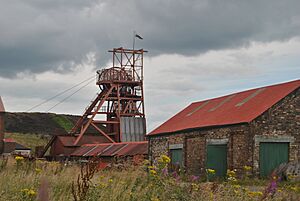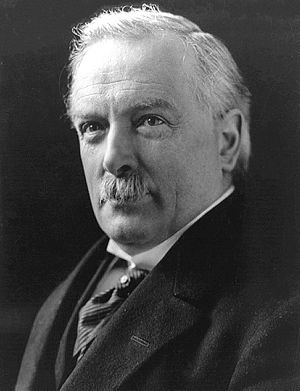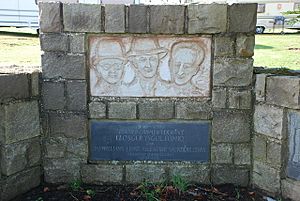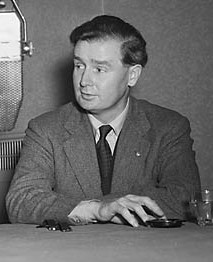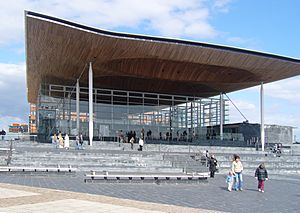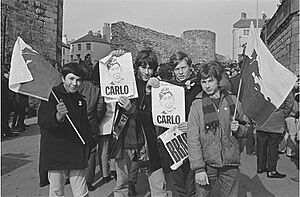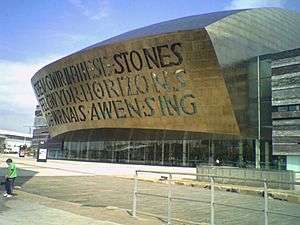Modern history of Wales facts for kids
The modern history of Wales began in 1800 and continues to today. In the 1800s, South Wales became very industrial, with many ironworks and coal mines. This led to a big increase in the number of people living there. The changes from industrialisation caused some protests against the owners, who were mostly English.
Later in the 1800s, a political idea called socialism grew in South Wales. Religious groups who were not part of the main church (called Nonconformists) also became more involved in politics. The first Member of Parliament (MP) from the Labour Party, Keir Hardie, was elected for a Welsh area in 1900.
The early 1900s were a time when coal mining was very popular in South Wales. The number of people living there grew by more than 20 percent! This also changed where people spoke Welsh. For example, in the Rhondda valley, the number of Welsh speakers dropped from 64 percent in 1901 to 55 percent ten years later. After the First World War, the Labour Party became more powerful than the Liberals in Wales, especially in the industrial valleys.
A Welsh political party called Plaid Cymru was started in 1925, but it grew slowly at first. After the Second World War, industries like coal and steel started to decline. By the early 1990s, there was only one deep coal mine left in Wales. The Welsh economy then started to rely more on service jobs, like in shops or offices.
The 2001 Census showed that more people were speaking Welsh again. About 21% of people aged 3 and older spoke Welsh, which was an increase from previous years.
The 1800s
Wales Becomes Industrial
In the early 1800s, parts of Wales became very industrial. Ironworks were built in the South Wales Valleys, especially around Merthyr Tydfil. Later, iron production moved west towards Neath and Swansea, where a type of coal called anthracite was already being mined. From the 1840s, coal mining spread to the Cynon and Rhondda valleys. This caused the population in these areas to grow very quickly.
The big changes from industrialisation led to conflicts between Welsh workers and the mostly English factory and mine owners. In the 1830s, there were two armed protests. One was in Merthyr Tydfil in 1831, and another was the Chartist protest in Newport in 1839, led by John Frost.
The Rebecca Riots happened between 1839 and 1844 in South and Mid Wales. These protests were by farmers and were about high fees on local roads (called tolls) and general poverty in the countryside.
Because of these protests, the government looked into the state of education in Wales. Three English officials, who didn't speak Welsh, wrote a report in 1847. They said that Welsh people were lazy and immoral, and blamed the Welsh language and Nonconformist religion for this. This made many people in Wales very angry, and they called it the "Treason of the Blue Books."
Later in the 1800s, the idea of socialism became popular in the industrial areas of South Wales. Religious Nonconformist groups also became more involved in politics. The first Labour MP, Keir Hardie, was elected for Merthyr Tydfil and Aberdare in 1900. Around the same time, groups like Cymru Fydd (meaning "Wales will be") started to push for more self-rule for Wales. This group was led by Liberal politicians like T. E. Ellis and David Lloyd George.
Farmers and Land
In the 1880s, there were signs that farmers in Wales might also protest. David Lloyd George and T. E. Ellis invited an Irish reformer, Michael Davitt, to Wales in 1886 to campaign for changes. Welsh reformers often compared their situation to Ireland, even though things were generally better in Wales. Farmers didn't show much interest, and economic conditions improved, so big changes didn't happen.
Religion in Wales
Another important movement in the 1880s was the campaign to separate the Church of England from the state in Wales. Many people felt that since most Welsh people were Nonconformists, the Church of England should not be the official church in Wales. This campaign continued for many years, and the Welsh Church Act 1914 finally made the change, though it only came into effect after the First World War in 1920.
How Many People Lived in Wales?
The 1800s saw a big increase in the number of people living in Wales. In 1801, there were about 587,000 people. By 1901, this number had grown to over 2,012,000! The population grew fastest in the first half of the century. Most of this growth happened in industrial areas like Monmouthshire and Glamorganshire. However, in rural areas like Montgomeryshire and Radnorshire, the population started to shrink from 1851. This was partly because farming changed and people moved to industrial areas for new jobs.
People Moving to Wales
Another big change in the late 1800s was people moving into Wales, especially to the industrial parts of Glamorgan and Monmouthshire. Wales was the only part of Britain that had more people moving in than out between 1860 and 1914. For example, between 1881 and 1891, over 48,000 people moved to Glamorgan from England.
The 1900s
The Economy Changes
The first ten years of the 1900s were a time of a huge coal boom in South Wales. The population grew by over 20 percent. By 1911, Glamorgan and Monmouthshire had 63 percent of all Welsh people. This also affected the Welsh language. The number of Welsh speakers in the Rhondda valley dropped from 64 percent in 1901 to 55 percent ten years later.
Politics in the 1900s
In the early 1900s, Wales mostly supported the Liberal Party, especially when David Lloyd George became Prime Minister during the First World War. But the Labour Party slowly gained power. After World War I, Labour replaced the Liberals as the main party in Wales, especially in the industrial valleys.
Plaid Cymru was formed in 1925, but it didn't get many votes at first. In 1936, three members of Plaid Cymru – Saunders Lewis, Lewis Valentine, and D. J. Williams – burned down an RAF training camp near Pwllheli. This was a protest against building the camp, known as "the bombing school," and destroying an old house called Penyberth to make space for it. This event and the imprisonment of the three men made Plaid Cymru much more well-known, especially in Welsh-speaking areas.
In 1955, Cardiff was named the capital city of Wales. In 1964, the first Secretary of State for Wales was appointed, leading the Welsh Office. This was the first step towards Wales getting more control over its own affairs. In 1967, a law that said "England" included Wales for legal reasons was removed.
Nationalism became a big topic in the second half of the 1900s. In 1962, Saunders Lewis gave a radio talk called Tynged yr iaith (The fate of the language). He said the Welsh language would disappear if people didn't act. This led to the creation of Cymdeithas yr Iaith Gymraeg (the Welsh Language Society) that same year.
In 1940, the community of Mynydd Epynt in Powys was forced to leave their homes. This included 200 people, 54 farms, and a pub. The UK Ministry of Defence did this to create a military training area.
Nationalist feelings grew even more after the flooding of the Tryweryn valley in 1965. This was done to create a reservoir to supply water to the English city of Liverpool. Even though almost all Welsh MPs voted against it, the UK Parliament passed the bill. The village of Capel Celyn was flooded, which showed how little power Wales had in its own affairs compared to the larger number of English MPs.
Some groups that wanted Wales to be separate, like the Free Wales Army and Mudiad Amddiffyn Cymru, were formed in the 1960s. Before the Investiture of Charles, Prince of Wales in 1969, these groups were responsible for some bomb attacks on buildings. In 1966, Gwynfor Evans won a parliamentary seat for Carmarthen, which was Plaid Cymru's first seat in Parliament.
The Welsh Language Act of 1967 changed the law so that Wales was no longer legally part of England. This made Wales a separate legal entity within the UK for the first time since the 1500s. The Act also allowed more use of Welsh, including in some legal situations.
Plaid Cymru gained more seats in the 1974 elections, winning three. More people in the Labour Party also started to support devolution (giving Wales more power). A bill for devolution was introduced in 1976. However, a vote (referendum) in 1979 on creating a Welsh assembly resulted in a large "no" vote.
The new Conservative government elected in 1979 had promised a Welsh-language TV channel but then said they wouldn't do it. This led to a campaign where some Plaid Cymru members refused to pay their TV licenses. In 1980, Gwynfor Evans announced he would go on a hunger strike until a Welsh channel was created. In September 1980, the government changed its mind, and S4C (the Welsh-language channel) was launched in November 1982. The Welsh Language Act 1993 gave the Welsh language equal status with English in public services in Wales.
In the 1979 referendum, Wales voted against creating a Welsh assembly by 80 percent. But in 1997, a second referendum on the same idea passed by a very small margin (50.3 percent). The National Assembly for Wales (Cynulliad Cenedlaethol Cymru) was set up in 1999. It could decide how Wales' government money was spent, but the UK Parliament still had the final say on its powers. The governments of the UK and Wales usually call Wales a country. The Welsh Government says: "Wales is not a Principality... Wales is a country in its own right."
In May 1997, a Labour government was elected and promised to create devolved governments in Scotland and Wales. A referendum was held in late 1997, and it resulted in a "yes" vote, though by a small margin. The Welsh Assembly was set up in 1999 and had the power to decide how the government budget for Wales was spent.
Coal Mining Declines
After the Second World War, many traditional industries, especially coal mining, started to decline. The South Wales coalfield, which once employed over 250,000 men around 1913, had only about 75,000 in the mid-1960s and 30,000 in 1979.
The coal mining industry in Britain became owned by the government in 1947. This meant Welsh mines were controlled by the National Coal Board. This period also saw the Aberfan disaster in 1966, when a pile of coal waste slid down and covered a school, killing 144 people, mostly children. By the early 1990s, only one deep coal mine was still working in Wales. Tower Colliery stayed open until 2008. The steel industry also declined, and the Welsh economy started to focus more on service jobs.
Religion in the 1900s
The Revival of 1904–1905 was the biggest Christian revival in Wales during the 1900s. This burst of religious excitement had a big effect on people and started similar revivals in other countries.
After 1945, some Welsh traditions, like religious non-conformity and Sunday closing laws, started to fade. However, Welsh distinctiveness also became stronger.
Population Changes
How Many People Lived in Wales?
Over the 1900s, the population of Wales grew from just over 2,012,000 in 1901 to 2.9 million in 2001. However, this wasn't a steady increase. About 430,000 people left Wales between 1921 and 1940, mostly because of the economic depression in the 1930s.
People moving into Wales from England became a big factor from the early 1900s. In that time, most newcomers settled in the growing industrial areas. This led to some parts of South and East Wales becoming more English-speaking.
Over the century, more people born outside Wales lived there. In 2001, 20% of Welsh residents were born in England, 2% in Scotland or Ireland, and 3% outside the UK. While early newcomers went to industrial areas, by the 1990s, the highest numbers of people born outside Wales were in areas like Ceredigion and Powys.
The Welsh Language
The number of people in Wales who could speak Welsh fell from almost 50% in 1901 to a low of 18.9% in 1981. However, the 2001 Census showed an increase to 21% of the population aged 3 and older. This was a change from the steady decline seen throughout the 1900s.
In the 2011 census, the number of Welsh speakers dropped slightly to 19%. Despite the overall population of Wales growing, the actual number of Welsh speakers went down from 582,000 in 2001 to 562,000 in 2011. However, this was still higher than the 508,000 speakers recorded in 1991.
More recent surveys show that the number of Welsh speakers is increasing again. From April 2020 to March 2021, about 29.1% of people aged three and over could speak Welsh, which is about 883,300 people.
The 2000s
The 2001 Census showed that more people were speaking Welsh again, with 21% of the population aged 3 and older speaking it. This was an increase compared to the end of the 1900s.
In Cardiff, the Millennium Stadium opened in 1999. Then, the Wales Millennium Centre opened in 2004 as a place for cultural events, like opera. The new Welsh Assembly building, called the Senedd, was finished in February 2006 and officially opened on St. David's Day that year.
More Devolution for Wales
In 2006, a new law called the Government of Wales Act was passed. This meant that from May 2007, the Queen would have a new legal role as "Her Majesty in Right of Wales." She would also appoint Welsh Ministers and sign Welsh Orders. The Act also allowed for a future vote (referendum) to ask Welsh people if they wanted the Welsh Assembly to have the power to make its own laws.
A referendum on giving the National Assembly more law-making powers was held on March 3, 2011. People were asked: "Do you want the Assembly now to be able to make laws on all matters in the 20 subject areas it has powers for?" The result was 63.49% voting "yes" and 36.51% voting "no." So, the Assembly can now make its own laws, called Acts of the Assembly, in these areas without needing the UK Parliament's approval.
In the 2016 referendum, Wales voted to leave the European Union. However, some areas, especially Welsh-speaking ones, did not want to leave the EU.
In 2011, the International Standards Organisation officially changed Wales' status from a principality to a country.
In May 2020, the National Assembly for Wales was renamed "Senedd Cymru" or "the Welsh Parliament," often called the "Senedd" in both English and Welsh.
In 2016, YesCymru was started. This group campaigns for an independent Wales. They held their first big event in Cardiff in 2019. Support for Welsh independence has grown, reaching as high as 40% in 2021.


